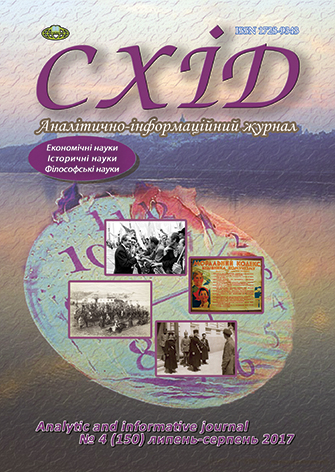The U.S. external debt: risks and prospects for developing the strategy of the U.S. external debt management
DOI:
https://doi.org/10.21847/1728-9343.2017.4(150).110508Keywords:
U.S. External Debt, liquidity, solvency, debt servicing, government external debt, debt financing, national debt, domestic debtAbstract
According to the modern widespread approaches to the nature of external debt and its effects on economic processes, debt financing is among the distinctive features of the liberalization-oriented world of nowadays. Accordingly, unrestricted capital flows signify orientation at macroeconomic balance, since under the conditions when administrative barriers are absent capital distribution is even and symmetric, enabling leveling of factor prices. Associated with these arguments is a claim that prices of goods and services do not indicate non-negligible fluctuations and a financial system gains economic agents' confidence. This research addresses the issues of the phenomenon of external debt and provides an insight into the U.S. external debt and its effects on both the U.S. and world economy. The findings show that the U.S. external debt is of no considerable threat to the world economy in the short-term, since the peace of the world's economic leader's growth exceeds that of debt servicing expenditures. However, an economic decline may turn the status-quo upside down, since the country may face inability to raise enough funds in time to discharge its financial liabilities, especially to non-residents.
Downloads
References
Heather, L. (2016). CNN Money. Retrieved 23 November, 2016, available at: http://money.cnn.com/2016/05/10/news/economy/us-debt-ownership/
Holtfrerich, C. (2013). Government Debt in Economic Thought of the Long 19th Century. School of Business & Economics, 4(4), 1-29.
IMF (2016). Financial Stability Challenges in Low-Growth, Low-Rate Area. In Imf (Ed), Global Financial Stability Report (GFSR) Fostering Stability in a Low-Growth, Low-Rate Era (pp. 1-48).Washington: IMF.
IMF. (2003). External Debt Statistics: Guide for Compilers and Users. Retrieved 29 November, 2016, available at: https://www.imf.org/external/pubs/ft/eds/Eng/Guide/
IMF Economic Outlook. (2016). Global Prospects and Policies. Retrieved 29 November, 2016, available at: https://www.imf.org/external/pubs/-ft/weo/2016/02/pdf/c1.pdf
Keynes, J.M. (1919). The Economic Consequences of the Peace, London: Macmillan (eng).
Krugman, P & Wells, R. (2013). Economics. Worth Publishing Ltd. New York (eng).
Krugman, P. (2015). Nobody Understands Debt. Retrieved 29 November, 2016, available at: http://www.nytimes.com/2015/02/09/opinion/paul-krugman-nobody-understands-debt.html?_r=0
Lerner, A. (1948). The Burden of National Debt. Essays in honor of Alvin H. Hansen. Norton and K. NY p. 141. (eng).
Lerner, A. (1955). Functional Finance and Federal Debt. Retrieved 29 November, 2016, available at: http://public.econ.duke.edu/~kdh9/Courses/-Graduate%20Macro%20History/Readings-1/Lerner%20Functional%20Finance.pdf.
Patton, M. (2016, 29th Ferbruary).U.S.Role In Global Economy Declines Nearly 50%. [Weblog]. Retrieved 20 November 2016, available at: http://www.forbes.com/sites/mikepatton/2016/02/29/u-s-role-in-global-economy-declines-nearly-50/#1feeebf459c1
Statista Portal (2016).United States: National debt from 2010 to 2020 (in billion US dollars). Retrieved 29 November, 2016, available at: https://www.statista.com/statistics/262893/national-debt-in-the-united-states/
Treasury direct (2016). Interest Expense on the Debt Outstanding. Retrieved 28 November, 2016, available at: https://www.treasurydirect.gov/govt/reports/ir/ir_expense.htm
U.S.Debt Clock. (2016). US Debt Clock. Retrieved 21 November, 2016, available at: http://www.usdebtclock.org
U.S.Department of the Treasury. (2016). Major Foreign Holders of Treasury Securities. Retrieved 23 November, 2016, available at: http://ticdata.treasury.gov/Publish/mfhhis01.txt
U.S.Department of the Treasury. (2015). Foreign Portfolio Holdings of US Securities. Retrieved 23 November, 2016, available at: http://ticdata.treasury.gov/Publish/shl2015r.pdf
U.S.Department of the Treasury. (2007). Report on Foreign Portfolio Holdings of US Securities. Retrieved 23 November, 2016, available at: http://ticdata.treasury.gov/Publish/shl2007r.pdf
UNCTAD. (2016). International Trade in Goods and Services . Retrieved 23 November, 2016, available at: http://unctadstat.unctad.org/wds/ReportFolders/reportFolders.aspx
U.S.Department of the Treasury. (2016). US International Reserve Position. Retrieved 23 November, 2016, available at: https://www.treasury.gov/resource-center/data-chart-center/IR-Position/Pages/default.aspx
U.S.Department of Commerce, Bureau of Economic Analysis. (2016). International Economic Accounts. Retrieved 28 November, 2016, available at: http://www.bea.gov/international/
Kosov, M. (2017), Public debt. Theoretical and methodological aspects, UNITY-DANA, Moskow, 159 p. (rus).
Downloads
Published
How to Cite
Issue
Section
License
Copyright (c) 2017 Andrii Pin

This work is licensed under a Creative Commons Attribution-NonCommercial-NoDerivatives 4.0 International License.
1. Authors bear responsibility for the accuracy of facts, quotations, numbers and names used.
2. Manuscripts are not sent back.
3. The publisher does not always agree with the authors' opinion.
4. The authors reserve the right to authorship of the work and pass the first publication right of this work to the journal under the terms of a Creative Commons Attribution-NonCommercial-NoDerivatives 4.0 International License. This license allows others to distribute (copy) the published work for non-commercial purposes, provided there is mandatory attribution to its authors and a link to the first publication in our journal.
5. The authors have the right to conclude separate supplement agreements that relate to non-exclusive work distribution in the form in which it has been published by the journal (for example, to upload the work to the online storage of the journal or publish it as part of a monograph), provided that the reference to the first publication of the work in this journal is included.

